-
Spiriva HandiHaler (Boehringer Ingelheim)
Prescribing Information
DESCRIPTION
SPIRIVA ® HandiHaler ® (tiotropium bromide inhalation powder) consists of a capsule dosage form containing a dry powder formulation of SPIRIVA (tiotropium bromide) intended for oral inhalation only with the HandiHaler inhalation device.
Each light green, hard gelatin capsule contains 18 mcg tiotropium (equivalent to 22.5 mcg tiotropium bromide monohydrate) blended with lactose monohydrate as the carrier.
The dry powder formulation within the capsule is intended for oral inhalation only.
The active component of SPIRIVA is tiotropium. The drug substance, tiotropium bromide monohydrate, is an anti-cholinergic with specificity for muscarinic receptors. It is chemically described as (1(alpha), 2(beta), 4(beta), 5(alpha), 7(beta))-7-[(Hy-droxydi-2-thienylacetyl)oxy]-9,9-dimethyl-3-oxa-9-azonia-tricyclo [3.3.1.0 2,4 ]nonane bromide monohydrate. It is a synthetic, non-chiral, quaternary ammonium compound. Tiotropium bromide is a white or yellowish white powder. It is sparingly soluble in water and soluble in methanol.
The structural formula is:
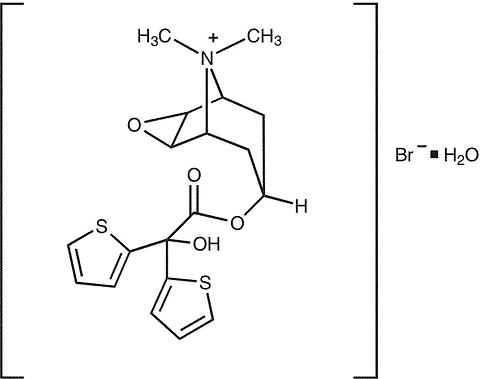
Tiotropium bromide (monohydrate) has a molecular mass of 490.4 and a molecular formula of C 19 H 22 NO 4 S 2 Br·H 2 O.
The HandiHaler is an inhalation device used to inhale the dry powder contained in the SPIRIVA capsule. The dry powder is delivered from the HandiHaler device at flow rates as low as 20 L/min. Under standardized in vitro testing, the HandiHaler device delivers a mean of 10.4 mcg tiotropium when tested at a flow rate of 39 L/min for 3.1 seconds (2L total). In a study of 26 adult patients with chronic obstructive pulmonary disease (COPD) and severely compromised lung function [mean FEV 1 1.02 L (range 0.45 to 2.24 L); 37.6% of predicted (range 16%-65%)], the median peak inspiratory flow (PIF) through the HandiHaler device was 30.0 L/min (range 20.4 to 45.6 L/min). The amount of drug delivered to the lungs will vary depending on patient factors such as inspiratory flow and peak inspiratory flow through the HandiHaler device, which may vary from patient to patient, and may vary with the exposure time of the capsule outside the blister pack.
For administration of SPIRIVA, a capsule is placed into the center chamber of the HandiHaler device. The capsule is pierced by pressing and releasing the button on the side of the inhalation device. The tiotropium formulation is dispersed into the air stream when the patient inhales through the mouthpiece. (see Patient's Instructions For Use )
CLINICAL PHARMACOLOGY
Mechanism of Action
Tiotropium is a long-acting, antimuscarinic agent, which is often referred to as an anticholinergic. It has similar affinity to the subtypes of muscarinic receptors, M 1 to M 5 . In the airways, it exhibits pharmacological effects through inhibition of M 3 -receptors at the smooth muscle leading to bronchodilation. The competitive and reversible nature of antagonism was shown with human and animal origin receptors and isolated organ preparations. In preclinical in vitro as well as in vivo studies prevention of methacholine-induced bronchoconstriction effects were dose-dependent and lasted longer than 24 hours. The bronchodilation following inhalation of tiotropium is predominantly a site-specific effect.
Pharmacokinetics
Tiotropium is administered by dry powder inhalation. In common with other inhaled drugs, the majority of the delivered dose is deposited in the gastrointestinal tract and, to a lesser extent, in the lung, the intended organ. Many of the pharmacokinetic data described below were obtained with higher doses than recommended for therapy.
Absorption:
Following dry powder inhalation by young healthy volunteers, the absolute bioavailability of 19.5% suggests that the fraction reaching the lung is highly bioavailable. It is expected from the chemical structure of the compound (quarternary ammonium compound) that tiotropium is poorly absorbed from the gastrointestinal tract. Food is not expected to influence the absorption of tiotropium for the same reason. Oral solutions of tiotropium have an absolute bioavailability of 2-3%. Maximum tiotropium plasma concentrations were observed five minutes after inhalation.
Distribution:
Tiotropium shows a volume of distribution of 32 L/kg indicating that the drug binds extensively to tissues. The drug is bound by 72% to plasma proteins. At steady state, peak tiotropium plasma levels in COPD patients were 17-19 pg/mL when measured 5 minutes after dry powder inhalation of an 18 mcg dose and decreased rapidly in a multi-compartmental manner. Steady state trough plasma concentrations were 3-4 pg/mL. Local concentrations in the lung are not known, but the mode of administration suggests substantially higher concentrations in the lung. Studies in rats have shown that tiotropium does not readily penetrate the blood-brain barrier.
Biotransformation:
The extent of biotransformation appears to be small. This is evident from a urinary excretion of 74% of unchanged substance after an intravenous dose to young healthy volunteers. Tiotropium, an ester, is nonenzymatically cleaved to the alcohol N -methylscopine and dithienylglycolic acid, neither of which bind to muscarinic receptors.
In vitro experiments with human liver microsomes and human hepatocytes suggest that a fraction of the administered dose (74% of an intravenous dose is excreted unchanged in the urine, leaving 25% for metabolism) is metabolized by cytochrome P450-dependent oxidation and subsequent glutathione conjugation to a variety of Phase II metabolites. This enzymatic pathway can be inhibited by CYP450 2D6 and 3A4 inhibitors, such as quinidine, ketoconazole, and gestodene. Thus, CYP450 2D6 and 3A4 are involved in the metabolic pathway that is responsible for the elimination of a small part of the administered dose. In vitro studies using human liver microsomes showed that tiotropium in supra-therapeutic concentrations does not inhibit CYP450 1A1, 1A2, 2B6, 2C9, 2C19, 2D6, 2E1, or 3A4.
Elimination:
The terminal elimination half-life of tiotropium is between 5 and 6 days following inhalation. Total clearance was 880 mL/min after an intravenous dose in young healthy volunteers with an inter-individual variability of 22%. Intravenously administered tiotropium is mainly excreted unchanged in urine (74%). After dry powder inhalation, urinary excretion is 14% of the dose, the remainder being mainly non-absorbed drug in the gut which is eliminated via the feces. The renal clearance of tiotropium exceeds the creatinine clearance, indicating active secretion into the urine. After chronic once-daily inhalation by COPD patients, pharmacokinetic steady state was reached after 2-3 weeks with no accumulation thereafter.
Drug Interactions:
An interaction study with tiotropium (14.4 mcg intravenous infusion over 15 minutes) and cimetidine 400 mg three times daily or ranitidine 300 mg once daily was conducted. Concomitant administration of cimetidine with tiotropium resulted in a 20% increase in the AUC 0-4h , a 28% decrease in the renal clearance of tiotropium and no significant change in the C max and amount excreted in urine over 96 hours. Co-administration of tiotropium with ranitidine did not affect the pharmacokinetics of tiotropium. Therefore, no clinically significant interaction occurred between tiotropium and cimetidine or ranitidine.
Electrophysiology:
In a multicenter, randomized, double-blind trial that enrolled 198 patients with COPD, the number of subjects with changes from baseline-corrected QT interval of 30-60 msec was higher in the SPIRIVA group as compared with placebo. This difference was apparent using both the Bazett (QTcB) [20 (20%) patient vs. 12 (12%) patients] and Fredericia (QTcF) [16 (16%) patients vs. 1 (1%) patient] corrections of QT for heart rate. No patients in either group had either QTcB or QTcF of >500 msec. Other clinical studies with SPIRIVA did not detect an effect of the drug on QTc intervals.
Special Populations:
Elderly Patients:
As expected for drugs predominantly excreted renally, advanced age was associated with a decrease of tiotropium renal clearance (326 mL/min in COPD patients <58 years to 163 mL/min in COPD patients >70 years), which may be explained by decreased renal function. Tiotropium excretion in urine after inhalation decreased from 14% (young healthy volunteers) to about 7% (COPD patients). Plasma concentrations were numerically increased with advancing age within COPD patients (43% increase in AUC 0-4 after dry powder inhalation), which was not significant when considered in relation to inter- and intra-individual variability. (See DOSAGE AND ADMINISTRATION )
Hepatically-impaired Patients:
The effects of hepatic impairment on the pharmacokinetics of tiotropium were not studied. However, hepatic insufficiency is not expected to have relevant influence on tiotropium pharmacokinetics. Tiotropium is predominantly cleared by renal elimination (74% in young healthy volunteers) and by simple non-enzymatic ester cleavage to products that do not bind to muscarinic receptors (See DOSAGE AND ADMINISTRATION )
Renally-impaired Patients:
Since tiotropium is predominantly renally excreted, renal impairment was associated with increased plasma drug concentrations and reduced drug clearance after both intravenous infusion and dry powder inhalation. Mild renal impairment (CrCl 50-80 mL/min), which is often seen in elderly patients, increased tiotropium plasma concentrations (39% increase in AUC 0-4 after intravenous infusion). In COPD patients with moderate to severe renal impairment (CrCl <50 mL/min), the intravenous administration of tiotropium resulted in doubling of the plasma concentrations (82% increase in AUC 0-4 ), which was confirmed by plasma concentrations after dry powder inhalation (See DOSAGE AND ADMINISTRATION and PRECAUTIONS )
CLINICAL STUDIES
The SPIRIVA HandiHaler clinical development program consisted of six phase 3 studies in 2,663 patients with COPD (1,308 receiving SPIRIVA): two 1-year, placebo-controlled studies, two 6-month, placebo-controlled studies and two 1-year, ipratropium-controlled studies. These studies enrolled patients who had a clinical diagnosis of COPD, were 40 years of age or older, had a history of smoking greater than 10 pack-years, had an FEV 1 less than or equal to 60 or 65% of predicted, and a ratio of FEV 1 /FVC of less than or equal to 0.7.
In these studies, SPIRIVA, administered once-daily in the morning, provided improvement in lung function (forced expiratory volume in one second, FEV 1 ), with peak effect occurring within 3 hours following the first dose.
In the 1-year, placebo controlled trials, the mean improvement in FEV 1 at 30 minutes was 0.13 liters (13%) with a peak improvement of 0.24 liters (24%) relative to baseline after the first dose (day 1). Further improvements in FEV 1 and FVC were observed with pharmacodynamic steady state reached by day 8 with once-daily treatment. The mean peak improvement in FEV 1 , relative to baseline, was 0.28 to 0.31 liters (28% to 31%), after 1 week (day 8) of once-daily treatment. Improvement of lung function was maintained for 24 hours after a single dose and consistently maintained over the 1-year treatment period with no evidence of tolerance.
In the two 6-month, placebo-controlled trials, serial spirometric evaluations were performed throughout daytime hours in Trial A (12 hours) and limited to 3 hours in Trial B. The serial FEV 1 values over 12 hours (Trial A) are displayed in Figure 1. These trials further support the improvement in pulmonary function (FEV 1 ) with SPIRIVA, which persisted over the spirometric observational period. Effectiveness was maintained for 24 hours after administration over the 6-month treatment period.
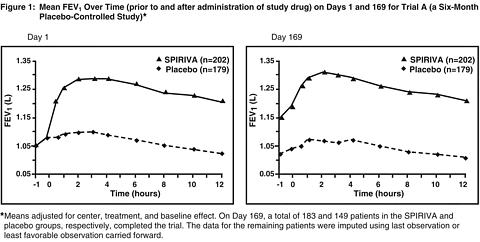
Results of each of the one-year ipratropium-controlled trials were similar to the results of the one-year placebo-controlled trials. The results of one of these trials are shown in Figure 2.
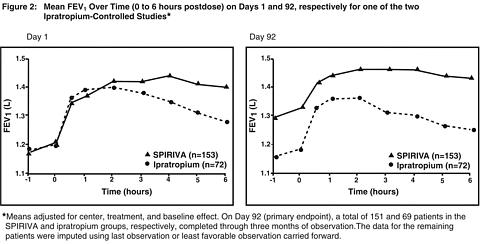
A randomized, placebo-controlled clinical study in 105 patients with COPD demonstrated that bronchodilation was maintained throughout the 24-hour dosing interval in comparison to placebo, regardless of whether SPIRIVA was administered in the morning or in the evening.
Throughout each week of the one-year treatment period in the two placebo-controlled trials, patients taking SPIRIVA had a reduced requirement for the use of rescue short-acting beta 2 -agonists. Reduction in the use of rescue short-acting beta 2 -agonists, as compared to placebo, was demonstrated in one of the two 6-month studies.
INDICATIONS AND USAGE
SPIRIVA HandiHaler is indicated for the long-term, once-daily, maintenance treatment of bronchospasm associated with chronic obstructive pulmonary disease (COPD), including chronic bronchitis and emphysema.
CONTRAINDICATIONS
SPIRIVA HandiHaler is contraindicated in patients with a history of hypersensitivity to atropine or its derivatives, including ipratropium, or to any component of this product.
WARNINGS
SPIRIVA HandiHaler is intended as a once-daily maintenance treatment for COPD and is not indicated for the initial treatment of acute episodes of bronchospasm, i.e., rescue therapy.
Immediate hypersensitivity reactions, including angioedema, may occur after administration of SPIRIVA. If such a reaction occurs, therapy with SPIRIVA should be stopped at once and alternative treatments should be considered.
Inhaled medicines, including SPIRIVA, may cause paradoxical bronchospasm. If this occurs, treatment with SPIRIVA should be stopped and other treatments considered.
PRECAUTIONS
General
As an anticholinergic drug, SPIRIVA may potentially worsen symptoms and signs associated with narrow-angle glaucoma, prostatic hyperplasia or bladder-neck obstruction and should be used with caution in patients with any of these conditions.
As a predominantly renally excreted drug, patients with moderate to severe renal impairment (creatinine clearance of </=50 mL/min) treated with SPIRIVA should be monitored closely. (See CLINICAL PHARMACOLOGY , Pharmacokinetics , Special Populations : Renally-impaired Patients )
Information for Patients
It is important for patients to understand how to correctly administer SPIRIVA capsules using the HandiHaler inhalation device. (See Patient's Instructions for Use ) SPIRIVA capsules should only be administered via the HandiHaler device and the HandiHaler device should not be used for administering other medications.
Capsules should always be stored in sealed blisters and only removed immediately before use. The blister strip should be carefully opened to expose only one capsule at a time. Open the blister foil as far as the STOP line to remove only one capsule at a time. The drug should be used immediately after the packaging over an individual capsule is opened, or else its effectiveness may be reduced. Capsules that are inadvertently exposed to air (i.e., not intended for immediate use) should be discarded.
Eye pain or discomfort, blurred vision, visual halos or colored images in association with red eyes from conjunctival congestion and corneal edema may be signs of acute narrow-angle glaucoma. Should any of these signs and symptoms develop, consult a physician immediately. Miotic eye drops alone are not considered to be effective treatment.
Care must be taken not to allow the powder to enter into the eyes as this may cause blurring of vision and pupil dilation.
SPIRIVA HandiHaler is a once-daily maintenance bronchodilator and should not be used for immediate relief of breathing problems, i.e., as a rescue medication.
Drug Interactions
SPIRIVA has been used concomitantly with other drugs commonly used in COPD without increases in adverse drug reactions. These include sympathomimetic bronchodilators, methylxanthines, and oral and inhaled steroids. However, the co-administration of SPIRIVA with other anticholinergic-containing drugs (e.g., ipratropium) has not been studied and is therefore not recommended.
Drug/Laboratory Test Interactions
None known.
Carcinogenesis, Mutagenesis, Impairment of Fertility
No evidence of tumorigenicity was observed in a 104-week inhalation study in rats at tiotropium doses up to 0.059 mg/kg/day, in an 83-week inhalation study in female mice at doses up to 0.145 mg/kg/day, and in a 101-week inhalation study in male mice at doses up to 0.002 mg/kg/day. These doses correspond to 25, 35, and 0.5 times the Recommended Human Daily Dose (RHDD) on a mg/m 2 basis, respectively. These dose multiples may be over-estimated due to difficulties in measuring deposited doses in animal inhalation studies.
Tiotropium bromide demonstrated no evidence of mutagenicity or clastogenicity in the following assays: the bacterial gene mutation assay, the V79 Chinese hamster cell mutagenesis assay, the chromosomal aberration assays in human lymphocytes in vitro and mouse micronucleus formation in vivo , and the unscheduled DNA synthesis in primary rat hepatocytes in vitro assay.
In rats, decreases in the number of corpora lutea and the percentage of implants were noted at inhalation tiotropium doses of 0.078 mg/kg/day or greater (approximately 35 times the RHDD on a mg/m 2 basis). No such effects were observed at 0.009 mg/kg/day (approximately 4 times than the RHDD on a mg/m 2 basis). The fertility index, however, was not affected at inhalation doses up to 1.689 mg/kg/day (approximately 760 times the RHDD on a mg/m 2 basis). These dose multiples may be over-estimated due to difficulties in measuring deposited doses in animal inhalation studies.
Pregnancy
Pregnancy Category C
No evidence of structural alterations was observed in rats and rabbits at inhalation tiotropium doses of up to 1.471 and 0.007 mg/kg/day, respectively. These doses correspond to approximately 660 and 6 times the recommended human daily dose (RHDD) on a mg/m 2 basis. However, in rats, fetal resorption, litter loss, decreases in the number of live pups at birth and the mean pup weights, and a delay in pup sexual maturation were observed at inhalation tiotropium doses of >/= 0.078 mg/kg (approximately 35 times the RHDD on a mg/m 2 basis). In rabbits, an increase in post-implantation loss was observed at an inhalation dose of 0.4 mg/kg/day (approximately 360 times the RHDD on a mg/m 2 basis). Such effects were not observed at inhalation doses of 0.009 and up to 0.088 mg/kg/day in rats and rabbits, respectively. These doses correspond to approximately 4 and 80 times the RHDD on a mg/m 2 basis, respectively. These dose multiples may be over-estimated due to difficulties in measuring deposited doses in animal inhalation studies.
There are no adequate and well-controlled studies in pregnant women. SPIRIVA should be used during pregnancy only if the potential benefit justifies the potential risk to the fetus.
Use in Labor and Delivery
The safety and effectiveness of SPIRIVA has not been studied during labor and delivery.
Nursing Mothers
Clinical data from nursing women exposed to tiotropium are not available. Based on lactating rodent studies, tiotropium is excreted into breast milk. It is not known whether tiotropium is excreted in human milk, but because many drugs are excreted in human milk and given these findings in rats, caution should be exercised if SPIRIVA is administered to a nursing woman.
Pediatric Use
SPIRIVA HandiHaler is approved for use in the maintenance treatment of bronchospasm associated with chronic obstructive pulmonary disease, including chronic bronchitis and emphysema. This disease does not normally occur in children. The safety and effectiveness of SPIRIVA in pediatric patients have not been established.
Geriatric Use
Of the total number of patients who received SPIRIVA in the 1-year clinical trials, 426 were <65 years, 375 were 65-74 years and 105 were >/=75 years of age. Within each age subgroup, there were no differences between the proportion of patients with adverse events in the SPIRIVA and the comparator groups for most events. Dry mouth increased with age in the SPIRIVA group (differences from placebo were 9.0%, 17.1%, and 16.2% in the aforementioned age subgroups). A higher frequency of constipation and urinary tract infections with increasing age was observed in the SPIRIVA group in the placebo-controlled studies. The differences from placebo for constipation were 0%, 1.8%, and 7.8% for each of the age groups. The differences from placebo for urinary tract infections were -0.6%, 4.6% and 4.5%. No overall differences in effectiveness were observed among these groups. Based on available data, no adjustment of SPIRIVA dosage in geriatric patients is warranted.
ADVERSE REACTIONS
Of the 2,663 patients in the four 1-year and two 6-month controlled clinical trials, 1,308 were treated with SPIRIVA at the recommended dose of 18 mcg once a day. Patients with narrow angle glaucoma, or symptomatic prostatic hypertrophy or bladder outlet obstruction were excluded from these trials.
The most commonly reported adverse drug reaction was dry mouth. Dry mouth was usually mild and often resolved during continued treatment. Other reactions reported in individual patients and consistent with possible anticholinergic effects included constipation, increased heart rate, blurred vision, glaucoma, urinary difficulty, and urinary retention.
Four multicenter, 1-year, controlled studies evaluated SPIRIVA in patients with COPD. Table 1 shows all adverse events that occurred with a frequency of >/=3% in the SPIRIVA group in the 1-year placebo-controlled trials where the rates in the SPIRIVA group exceeded placebo by >/=1%. The frequency of corresponding events in the ipratropium-controlled trials is included for comparison.
Table 1: Adverse Experience Incidence (% Patients) in One-Year-COPD Clinical Trials Body System (Event)Placebo-Controlled Trials Ipratropium-Controlled Trials SPIRIVA
[n=550]Placebo
[n=371]SPIRIVA
[n=356]Ipratropium
[n=179]Body as a WholeAccidents13 11 5 8 Chest Pain (non-specific)7 5 5 2 Edema, Dependent5 4 3 5 Gastrointestinal System DisordersAbdominal Pain5 3 6 6 Constipation4 2 1 1 Dry Mouth16 3 12 6 Dyspepsia6 5 1 1 Vomiting4 2 1 2 Musculoskeletal SystemMyalgia4 3 4 3 Resistance Mechanism DisordersInfection4 3 1 3 Moniliasis4 2 3 2 Respiratory System (upper)Epistaxis4 2 1 1 Pharyngitis9 7 7 3 Rhinitis6 5 3 2 Sinusitis11 9 3 2 Upper Respiratory
Tract Infection41 37 43 35 Skin and Appendage DisordersRash4 2 2 2 Urinary SystemUrinary Tract Infection7 5 4 2 Arthritis, coughing, and influenza-like symptoms occurred at a rate of >/=3% in the SPIRIVA treatment group, but were <1% in excess of the placebo group.
Other events that occurred in the SPIRIVA group at a frequency of 1-3% in the placebo-controlled trials where the rates exceeded that in the placebo group include: Body as a Whole: allergic reaction, leg pain; Central and Peripheral Nervous System: dysphonia, paresthesia; Gastrointestinal System Disorders: gastrointestinal disorder not otherwise specified (NOS), gastroesophageal reflux, stomatitis (including ulcerative stomatitis); Metabolic and Nutritional Disorders: hypercholesterolemia, hyperglycemia; Musculoskeletal System Disorders: skeletal pain; Cardiac Events: angina pectoris (including aggravated angina pectoris); Psychiatric Disorder: depression; Infections: herpes zoster; Respiratory System Disorder (Upper): laryngitis; Vision Disorder: cataract. In addition, among the adverse events observed in the clinical trials with an incidence of <1% were atrial fibrillation, supraventricular tachycardia, angioedema, and urinary retention.
In the 1-year trials, the incidence of dry mouth, constipation, and urinary tract infection increased with age. (See PRECAUTIONS , Geriatric Use )
Two multicenter, 6-month, controlled studies evaluated SPIRIVA in patients with COPD. The adverse events and the incidence rates were similar to those seen in the 1-year controlled trials.
In addition to adverse events identified during clinical trials, the following adverse reactions have been reported in the worldwide post-marketing experience: epistaxis, palpitations, pruritus, and urticaria.
OVERDOSAGE
High doses of tiotropium may lead to anticholinergic signs and symptoms. However, there were no systemic anticholinergic adverse effects following a single inhaled dose of up to 282 mcg tiotropium in 6 healthy volunteers. In a study of 12 healthy volunteers, bilateral conjunctivitis and dry mouth were seen following repeated once-daily inhalation of 141 mcg of tiotropium.
Acute intoxication by inadvertent oral ingestion of SPIRIVA capsules is unlikely since it is not well-absorbed systemically.
A case of overdose has been reported from post-marketing experience. A female patient was reported to have inhaled 30 capsules over a 2.5 day period, and developed altered mental status, tremors, abdominal pain, and severe constipation. The patient was hospitalized, SPIRIVA was discontinued, and the constipation was treated with an enema. The patient recovered and was discharged on the same day.
No mortality was observed at inhalation tiotropium doses up to 32.4 mg/kg in mice, 267.7 mg/kg in rats, and 0.6 mg/kg in dogs. These doses correspond to 7,300, 120,000, and 850 times the recommended human daily dose on a mg/m 2 basis, respectively. These dose multiples may be over-estimated due to difficulties in measuring deposited doses in animal inhalation studies.
DOSAGE AND ADMINISTRATION
The recommended dosage of SPIRIVA HandiHaler is the inhalation of the contents of one SPIRIVA capsule, once-daily, with the HandiHaler inhalation device. (See Patient's Instructions for Use )
No dosage adjustment is required for geriatric, hepatically-impaired, or renally-impaired patients. However, patients with moderate to severe renal impairment given SPIRIVA should be monitored closely. (See CLINICAL PHARMACOLOGY , Pharmacokinetics , Special Populations and PRECAUTIONS )
SPIRIVA capsules are for inhalation only and must not be swallowed.
HOW SUPPLIED
SPIRIVA capsules, containing 18 mcg tiotropium, are light green, with TI01 printed on one side of the capsule and the Boehringer Ingelheim company logo on the other side.
The HandiHaler inhalation device is gray colored with a green button. It is imprinted with SPIRIVA HandiHaler (tiotropium bromide inhalation powder), the Boehringer Ingelheim company logo, and the Pfizer company logo. It is also imprinted to indicate that SPIRIVA capsules should not be stored in the HandiHaler device and that the HandiHaler device is only to be used with SPIRIVA capsules.
Six SPIRIVA capsules are packaged in an aluminum/PVC/aluminum blister card. One blister card consists of two blister strips, each containing 3 capsules and joined along a perforated-cut line. After using the first capsule, the 2 remaining capsules should be used over the next 2 consecutive days. Capsules should always be stored in the blister and only removed immediately before use. The foil lidding should only be peeled back as far as the STOP line printed on the blister foil to prevent exposure of more than one capsule. The drug should be used immediately after the packaging over an individual capsule is opened.
The following packages are available:
carton containing 6 SPIRIVA capsules (1 blister card) and 1 HandiHaler inhalation device (NDC 0597-0075-06)
carton containing 30 SPIRIVA capsules (5 blister cards) and 1 HandiHaler inhalation device (NDC 0597-0075-37)
Storage
Store at 25°C (77°F); excursions permitted to 15-30°C (59-86°F) [see USP Controlled Room Temperature].
The capsules should not be exposed to extreme temperature or moisture. Do not store capsules in the HandiHaler device.
Rx only
Manufactured by:
Boehringer Ingelheim Pharma GmbH & Co. KG
Ingelheim, Germany
Marketed by:
Boehringer Ingelheim Pharmaceuticals, Inc.
Ridgefield, CT 06877 USA
and
Pfizer Inc.
New York, NY 10017 USA
Address Medical Inquiries to:
www.Spiriva.com or (800) 542-6257
Licensed from Boehringer Ingelheim International GmbH.
SPIRIVA ® and HandiHaler ® are registered trademarks and are used under license from Boehringer Ingelheim International GmbH
© Copyright Boehringer Ingelheim International GmbH 2004
ALL RIGHTS RESERVED
Tiotropium bromide is covered by U.S. Patent No. 5,610,163 with other Patents Pending. The HandiHaler inhalation device is covered by U.S. Design Patent No. 355,029.
59873/US/2 September 2004
PATIENT'S INSTRUCTIONS FOR USE
Spiriva® HandiHaler®
(tiotropium bromide inhalation powder)
FOR ORAL INHALATION ONLY
Read all instructions before use.
This leaflet provides summary information about SPIRIVA capsules and the HandiHaler inhalation device. Before you start to take SPIRIVA or use the HandiHaler, read this leaflet carefully and keep it for future use. You should read the leaflet that comes with your prescription every time you refill it because there may be new information.
For more information, ask your health-care provider or pharmacist.
What should you know about SPIRIVA and the HandiHaler?
Each SPIRIVA capsule contains a dry powder blend of active drug (18 mcg tiotropium) and lactose monohydrate as the carrier. The dry powder in the capsule is inhaled from the HandiHaler inhalation device. SPIRIVA capsules contain only a small amount of powder and as a result the capsule is only partially filled. When disposing of the capsule, you may notice that a tiny amount of this powder is left in the capsule. This is normal.
SPIRIVA is a once daily maintenance bronchodilator medicine that opens narrowed airways and helps keep them open for 24 hours. SPIRIVA HandiHaler should not be used for immediate relief of breathing problems, i.e., as a rescue medication.
SPIRIVA CAPSULES ARE INTENDED FOR ORAL INHALATION ONLY AND ARE TO BE USED ONLY WITH THE HANDIHALER INHALATION DEVICE.
SPIRIVA CAPSULES SHOULD NOT BE SWALLOWED.
The HandiHaler is an inhalation device that has been specially designed for use with SPIRIVA capsules. It must not be used to take any other medication.
Care must be taken not to allow the powder to enter into the eyes. If symptoms of eye pain, eye discomfort, blurred vision, visual halos, or colored images in association with red eyes occur, consult a physician immediately.
How do you take your dose of SPIRIVA using the HandiHaler?
Taking your dose of SPIRIVA, requires four main steps: Open the blister and the HandiHaler device, insert the SPIRIVA capsule, press the HandiHaler button, and inhale your medication. (See below for details.)
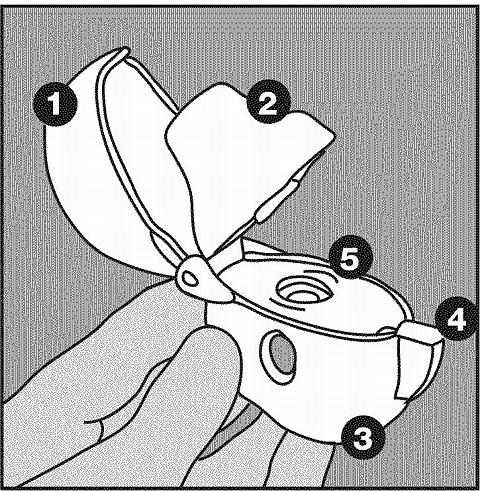
Become familiar with the components of the HandiHaler inhalation device:
1. dust cap
2. mouthpiece
3. base
4. piercing button
5. center chamber
Removing the SPIRIVA capsule from the blister.
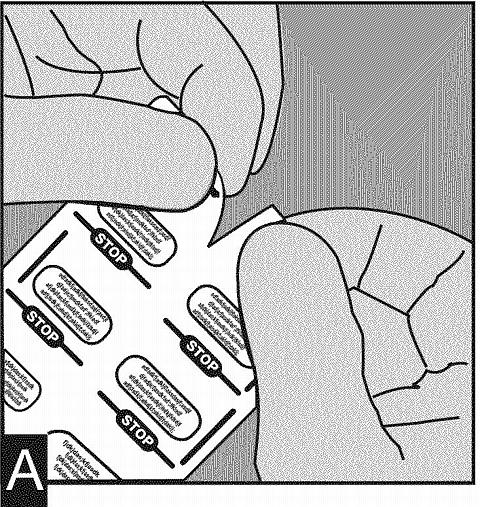
A) SPIRIVA capsules are packaged in a blister card. Each blister card consists of two blister strips, each containing 3 capsules and joined along a perforated-cut line. Prior to removing the first capsule from the blister card, separate the blister strips by tearing along the perforation. (Figure A)
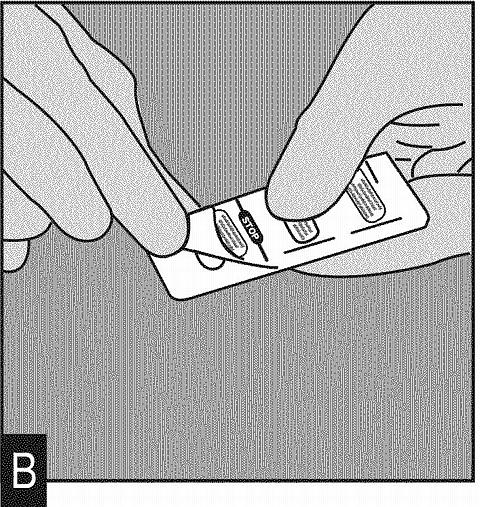
B) The blister should be carefully opened to expose only one capsule at a time. Immediately before you are ready to use your dose of SPIRIVA, peel back the aluminum foil using the tab until one capsule is fully visible. The foil lidding should only be peeled back as far as the STOP line printed on the blister foil to prevent exposure of more than one capsule. (Figure B) After using the first capsule, the 2 remaining capsules should be used over the next 2 consecutive days.
Capsules should always be stored in the sealed blisters and only removed immediately before use. The drug should be used immediately after the packaging over an individual capsule is opened, or else its effectiveness may be reduced. If additional capsules are inadvertently exposed to air, they should not be used and should be discarded.
Do not store capsules in the HandiHaler device.
Opening the HandiHaler device and inserting the SPIRIVA capsule.
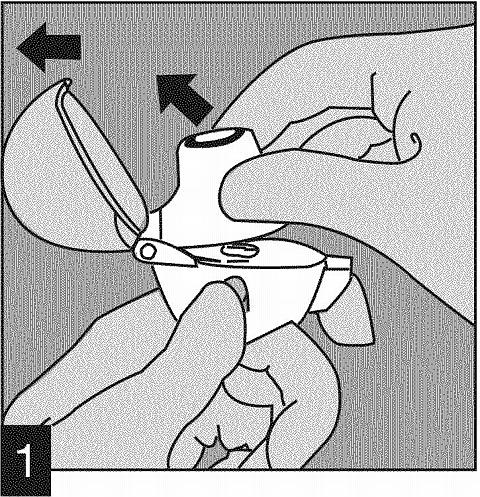
1) OPEN: Open the dust cap by pulling it upwards. Then open the mouthpiece. (Figure 1)
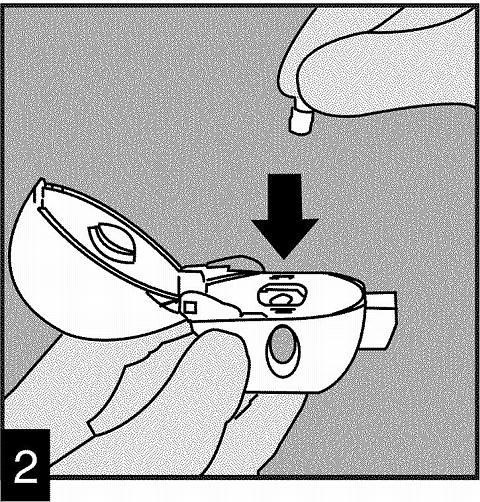
2) INSERT: Place the capsule in the center chamber. It does not matter which end of the capsule is placed in the chamber. (Figure 2)
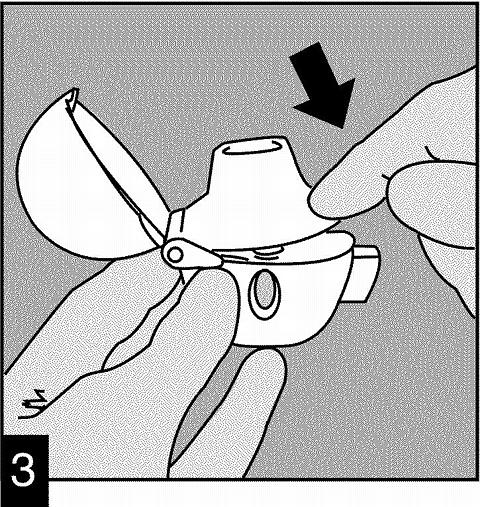
3) Close the mouthpiece firmly until you hear a click, leaving the dust cap open. (Figure 3)
Taking your dose of SPIRIVA.

4) PRESS: Hold the HandiHaler device with the mouthpiece upwards and press the piercing button completely in once, and release. This makes holes in the capsule and allows the medication to be released when you breathe in. (Figure 4)
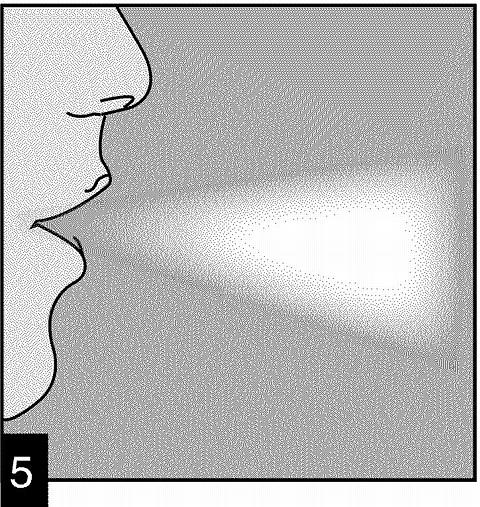
5) Breathe out completely. (Figure 5)
Important: Do not breathe into the mouthpiece at any time.
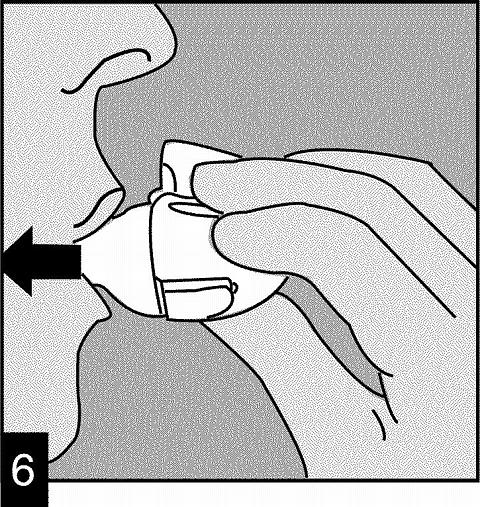
6) INHALE: Raise the HandiHaler device to your mouth and close your lips tightly around the mouthpiece. Keep your head in an upright position and breathe in slowly and deeply but at a rate sufficient to hear the capsule vibrate . Breathe in until your lungs are full; then hold your breath as long as is comfortable and at the same time take the HandiHaler device out of your mouth. Resume normal breathing. (Figure 6)
To ensure you get the full dose of SPIRIVA, you must repeat steps 5 and 6 once again.
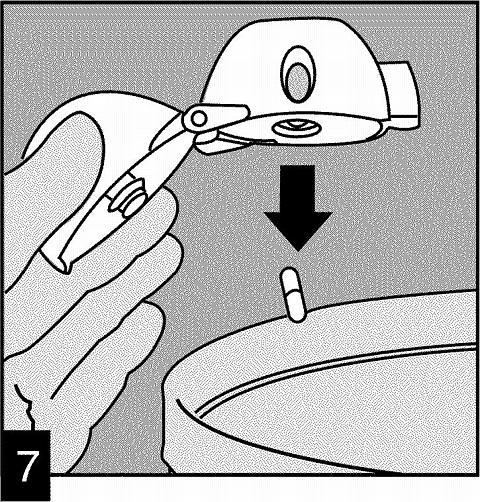
7) After you have finished taking your daily dose of SPIRIVA, open the mouthpiece again. Tip out the used capsule and dispose. (Figure 7)
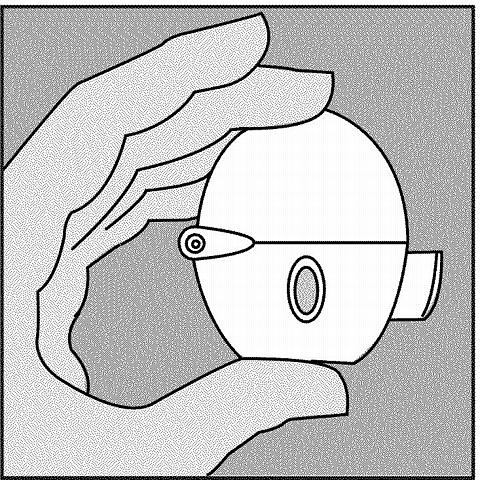
Close the mouthpiece and dust cap for storage of your HandiHaler device.
When and how should you clean your HandiHaler Device?
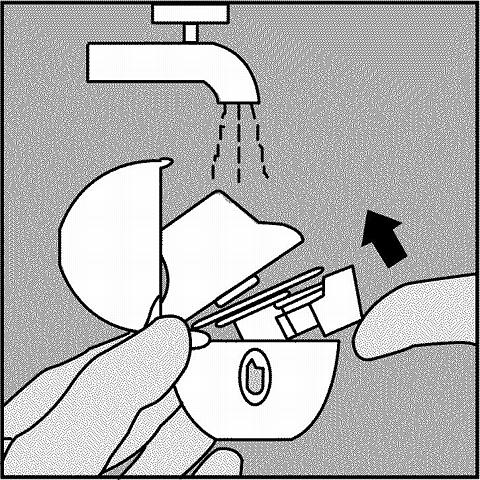
Normally, during a one-month period of use, the HandiHaler device does not need to be cleaned. However, if cleaning is needed the HandiHaler device can be cleaned as described below:
Open the dust cap and mouthpiece. Open the base by lifting the piercing button. Rinse the complete inhaler with warm water to
remove any powder. Do not use cleaning agents or detergents.
Dry the HandiHaler device thoroughly by tipping the excess water out on a paper towel and air-dry afterwards, leaving the dust cap, mouthpiece and base open. It takes 24 hours to air dry, so clean it right after you use it and it will be ready for your next dose. Do not use the HandiHaler device when it is wet.
If needed, the outside of the mouthpiece may be cleaned with a moist, but not wet tissue.
The HandiHaler device should not be placed in the dishwasher for cleaning.
Where should you store SPIRIVA capsules and the HandiHaler Device?
Store at 25°C (77°F); excursions permitted to 15-30°C (59-86°F) [see USP Controlled Room Temperature].
The capsules should not be exposed to extreme temperature or moisture. Do not store capsules in the HandiHaler.
As with all prescription medications, keep this out of the reach of children.
Tell your doctor before you use SPIRIVA HandiHaler:
if you may be pregnant or wish to become pregnant;
if you are a breastfeeding mother;
if you are taking any medications including eye drops, this includes those you can buy without a prescription;
if you have any other medical problems such as difficulty urinating or an enlarged prostate;
if you are allergic to any medications.
USE THIS PRODUCT AS DIRECTED, UNLESS INSTRUCTED TO DO OTHERWISE BY YOUR PHYSICIAN.
Manufactured by:
Boehringer Ingelheim Pharma GmbH & Co. KG
Ingelheim, Germany
Marketed by:
Boehringer Ingelheim Pharmaceuticals, Inc.
Ridgefield, CT 06877 USA
and
Pfizer Inc.
New York, NY 10017 USA
Licensed from Boehringer Ingelheim International GmbH.
SPIRIVA ® and HandiHaler ® are registered trademarks and are used under license from Boehringer Ingelheim International GmbH
© Copyright Boehringer Ingelheim International GmbH 2004
ALL RIGHTS RESERVED
Tiotropium bromide is covered by U.S. Patent No. 5,610,163 with other Patents Pending. The HandiHaler inhalation device is covered by U.S. Design Patent No. 355,029.
59873/US/2
September 2004
Subscribe to the "News" RSS Feed 
TOP ۞
